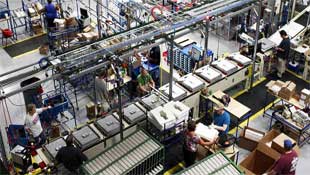| |
|
| |
|
 |
Supply
Chain by the Numbers |
| |
|
| |
- Jan. 10, 2019 -
|
| |
|
| |
|
| |
|
| |
Truck Platooning Not Worth It? Returns Continue to Grow for Etailers; Amazon Wants Inside Your Garage; It was a Big Year for US Manufacturing Jobs |
| |
|
| |
| |
| |
| |
4% |
|
That was the improvement in miles per gallon performance generally expected to come from so-called truck platooning, which involves the use of vehicle-to-vehicle communications and sensors, such as cameras and radar, to virtually connect two or more trucks together in a convoy. This allows the trucks to travel with less space between them, reducing drag. In part because a driver would remain in each cab and thus reduce safety concerns, many believed platooning would take hold and be a sort of bridge towards a future world of autonomous trucks. But maby not. Last week, Martin Daum, the head of Daimler's truck and bus divisions, said the major truck maker has decided to pass on platooning and focus instead on advancing its position in vehicle automation. Simply put, Daum said, all the technology required to make platooning work actually produces very limited reductions in operating cost. "The technology we have to put into a truck does not qualify the savings our customers will see with automation," Daum said. |
|
|
| |
| |
|
|
|
That's how much it will cost for a Chamberlain myQ Smart Garage Hub – which you will need if you want Amazon to deliver packages all the way into your garage, rather than the risky approach of leaving them on front porches. In early 2019, Amazon will begin to offer the service the company announced Monday at Consumer Electronics Show. The service is called Key for Garage, and joins Amazon's Key for Home and Key for Car services. The Garage Hub will let Amazon talk to your garage door opener so that it can be opened by a delivery person. You'll also need an Amazon Prime subscription. Unlike Key for Home, you don't need a camera to record the delivery. This method of delivery might be welcomed by people who didn't like Key for Home (previously simply known as Amazon Key), which didn't always work well if you had dogs at home, didn't want to let Amazon into your house, or had an alarm system.
|
| |
| |
|
| |
| |
| |
284,000 |
 |
That was the number of net job gains the US manufacturing industry posted in 2018, capping its best calendar year since 1997. By comparison, US manufacturing added 207,000 jobs in 2017. A priority for President Donald Trump, manufacturing saw continued strong hiring in December with an additional 32,000 jobs, according to a recent report from the Labor Department. Most of the gains occurred in blue-collar durable goods manufacturing, with growth in fabricated metals and computer and electronic products, the Labor Department said in a press release. In fact, the National Association of Manufacturers estimates US manufacturers currently face "a workforce crisis," with more than half a million open jobs today, and 2.4 million jobs expected to go unfilled over the next decade. So the tables have really turned, where the issue is no longer not enough manufacturing jobs, but rather not enough willing or qualified workers to fill the available jobs. |
| |
| |
| |
|
|
|
| |
 |
 |
| |
|
|
| |